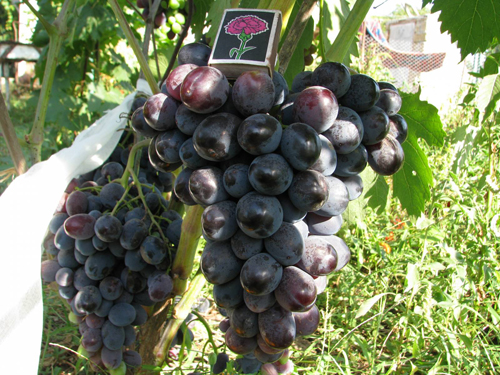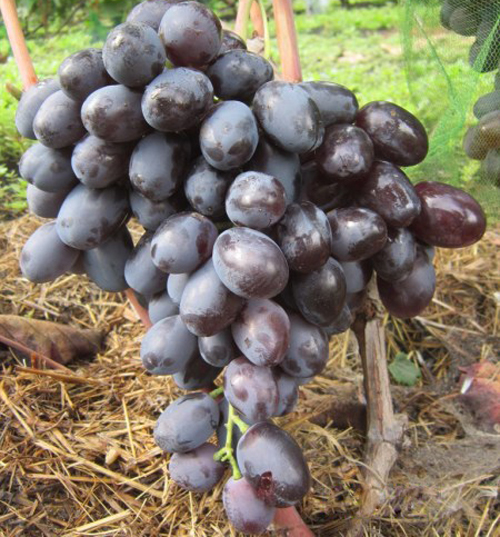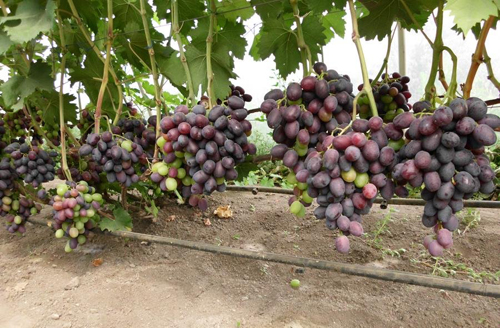Grape variety Furshetny
The hybrid form of table grapes Furshetny was born relatively recently, on the site of one of the most famous folk breeders from Ukraine - Vitaly Zagorulko. From the very first years of its appearance, it attracted the attention of many winegrowers due to the remarkable taste and marketability of the fruits, high yield and good resistance to unfavorable growing conditions. In the wake of rush demand, the price of seedlings reached sky-high heights, and decreased only after the widespread distribution of the variety.

The hybrid inherited many of its qualities from its parents. So, the author used a popular variety as the maternal form Gift to Zaporizhzhia, and as a father's - Kuban. The pair, by the way, is often used by the researcher. A number of other known varieties of Zagorulko originated from the same crossing. Among them, Furshetny is deservedly one of the most popular today.
Today the variety can be found on many plots of amateur winegrowers and farmers; from a scarce novelty, this grape has turned into a "workhorse" that brings both moral satisfaction and income to its owners.
Agrobiological characteristics
The plants are very vigorous, which, moreover, have a high shoot-forming ability. The crown is open, yellowish-green, not pubescent, without bright anthocyanin tones. The leaf is large, rounded, flat or funnel-shaped, consists of five lobes, moderately dissected between each other. The surface of the leaf blade is dark green with light veins, reticulate wrinkled; pubescence on the dorsum is absent. Upper sidecuts are of medium depth, open with parallel sides and a rounded bottom, or closed with an ovoid lumen. The depth of the lower notches is slightly less than the upper ones, the shape is V-shaped, or slit-like. The petiole notch is open, vaulted or lancet. Petioles are long, intensely reddish. The teeth along the edges of the leaf are triangular, with an average base width, straight edges and rounded apices. The flowers are bisexual, due to which pollination occurs well, and only under the most unfavorable weather conditions during flowering, a certain pea of berries can be observed. Scattering of flowers and ovary was not noticed in grapes. The annual growth has time to mature well during the growing season, while the shoots become dull brown.

The bunches of Furshetny are very large, cylindrical-conical, rarely branched, of medium density. The mass of the brushes in the variety usually ranges from 600-1000 grams, but outstanding specimens can reach 2 kg. The combs are strong, greenish-red, not too long. The berries are massive, oblong, 34-36 mm long and 24-28 mm in diameter, colored dark blue or red-violet and covered with a thick protective waxy layer. The average weight of ripe grapes is 10-12 grams, the largest - up to 20 grams. The berries in a bunch are not always distinguished by good evenness, however, in general, the brushes can be described as quite attractive in appearance. The pulp of the fruit is sweet, fleshy and juicy with an original fruity taste, in which tones of plum or mulberry are felt, but without bright varietal notes in the aroma. Accurate data on sugar content and titratable acidity in berry juice has not yet been presented, however, both the author and many winegrowers confirm the harmonious relationship of these parameters. The skin of the grapes, thin, but at the same time strong enough, is practically not felt when chewed. The bones in the pulp are present, but also do not cause significant negative sensations when eating. The tasting characteristics of the grapes are highly rated.
There can be several directions for using the obtained crop, but the main one, of course, is fresh consumption.Furshetny has established itself as a "market" variety, possessing all the qualities necessary for a high interest in it from buyers. Excellent presentation and bright memorable taste does not leave him a chance to lie on the counter. Its portability is at its height, thanks to which the harvested grapes can be moved over long distances without loss, significantly expanding the possibilities for its implementation. And it can be stored for a rather long period, especially if refrigerators or rooms with an optimal microclimate are used for this. The only drawback for the farmers who cultivate it for sale is not the earliest maturation of our hero. At this time, more and more offers appear on the market, and the price naturally begins to decline, which, of course, does not reflect in the best way on the profitability of crop cultivation. For amateurs in gardening and household plots, the hybrid is interesting for its unpretentiousness with high quality and large volume of grapes obtained. Surplus of rich harvests here are successfully used in home canning, making fruit compotes, juices, preserves and jams, excellent in taste and color.

The variety belongs to the early-middle group, which means that the harvest is ready for harvesting in the south - at the end of August, and slightly to the north - in the first or second decade of September. The growing season is 115-125 days. The countdown is traditionally carried out from the day of budding in the spring, until the fruits reach the conditions indicating their removable ripeness. The sum of active temperatures required for full ripening is 2500-2600 ° C. With such an indicator, Furshetny can be cultivated not only in traditional wine-growing regions, but also in a number of areas of the middle zone. The latitude of such cities as Tambov, Lipetsk and Orel can be considered the northern border of the cultivation of these grapes, according to the level of SAT.
With this advancement of the variety to the north, it is necessary to take into account not only the sufficient supply of plants with warmth in summer, but also the ability of the vine to endure winter frosts without significant damage. In this regard, the hybrid is not outstanding, possessing frost resistance at -22 ° C, which means the need for almost universal shelter of bushes for the winter. In the harshest conditions, insulation must be done very carefully.
With regard to productivity, there can be no complaints about our hero. From each adult, well-developed bush, up to 20 kg of ripe grapes are annually obtained. The fruitfulness of the shoots is 60-70%, and on the shoots, two or even more inflorescences are often laid. Because of this, the plants show a tendency to overload, and if the yields are not standardized, such signs of excessive stress may appear as a deterioration in the vigor of shoot growth, small fruitiness, watery pulp of berries and a decrease in sugar accumulation, lengthening of the growing season and insufficient maturation of the vine. Some of these problems threaten not only this year's harvest, but also have far-reaching consequences, causing weakening of plants and even their possible death as a result of insufficient preparation for winter.
After the onset of removable maturity, leaving the grapes hanging on the bushes is impractical, because the berries of this variety are susceptible to cracking in the event of rainy weather or a sharp change in soil moisture. Even at the ripening stage, it is recommended to pay attention to the regulation of the water regime of the soil, avoiding its strong drying out, due to which, at the very first rain, a massive "crackle" of fruits may begin. In addition, the overripe harvest of Furshetnoye, according to some reviews, significantly reduces its taste properties, which also does not add to the desire to experiment with late harvesting. Wasps and other insects show no interest in the berries of our hero exactly as long as the skin on them remains intact. As soon as even small cracks appear in the skin, pests rush to them en masse. Therefore, the protection of the bunches, in the form of individual mesh bags, will definitely not be superfluous.
Agrotechnical features
The economic characteristics of the variety, with the exception of some of the aforementioned problems associated with flaws in agrobiology, are very worthy, in connection with which it can be called relatively unpretentious in terms of growing conditions.
Furshetny does not impose special requirements on soil conditions at the vineyard site, and also differs in modesty in terms of the level of heat supply. At the same time, it is not recommended to use wet, swampy or highly saline soils, lands with high groundwater levels, northern slopes, as well as lowlands and gullies where cold air stagnates, for planting. In non-traditional wine-growing regions of the middle zone of the country, the requirements are somewhat tougher. Here, due to the risk of insufficient ripening of grapes in cool seasons, it is advisable to plant in the upper part of the slopes of the southern exposure, and in the flat areas, in particular in the backyards, protected from northern winds with the help of existing buildings, in the form of the so-called. "Wall" culture.
Both common methods are suitable for reproduction - by self-rooted cuttings, or grafted seedlings. The first, due to its lightness, has an undeniable advantage over the second, but it is possible only in those regions where the soil is free from the malicious soil pest, phyloxera. If the future vineyard is located in the zone of root aphid infestation, then the grower has no choice but to use seedlings grafted on phylloxera-resistant rootstocks for planting. The food area allocated for vigorous plants should not be less than 5-5.5 square meters. The form of management of grape bushes, and this is recognized by the author of the variety, mainly covering. In particular, in order to be able to remove the vine from the trellis every year without damage, he recommends using the version of a standard-free multi-arm fan.
The normalization of the load of fruiting bushes should be as follows: first, during spring pruning, 40-50 buds are left on them, shortening the fruit arrows to 5-8 eyes. After the debris on the plant, there should be 25-30 fruitful shoots. Before flowering, the number of inflorescences is necessarily thinned out on them, observing the basic rule for large-fruited varieties: one shoot - one bunch. And only in this form can the load be considered adjusted.
Furshetny resists diseases well, and therefore the plants will not require frequent and repeated treatments with fungicides. To maintain the phytosanitary state of the vineyard at the proper level, three standard complex spraying will be required - two before the flowering of the grapes, and one after.








